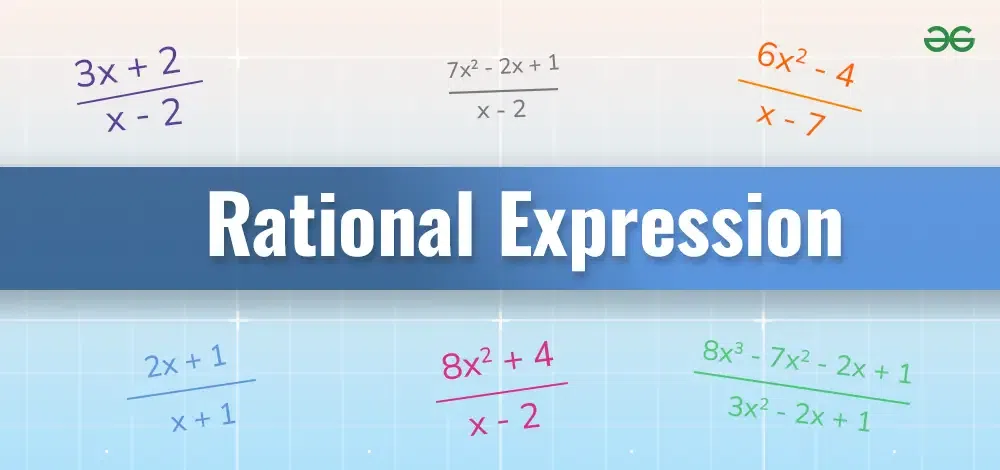
|
|
A rational expression is essentially a fraction where both the numerator and the denominator are polynomials. This means it is an algebraic expression that can be written in the form P(x)/Q(x), where P(x) and Q(x) are polynomials, and Q(x) ≠ 0. Just like regular fractions, rational expressions can be simplified, added, subtracted, multiplied, and divided. In this article, we will discuss Rational Expression in detail including operations and solved examples as well.  Table of Content What is a Rational Expression?A rational expression is a mathematical expression that represents the ratio of two polynomials. In other words, it is a fraction where the numerator and the denominator are both polynomials. These expressions are similar to rational numbers, which are ratios of integers, but instead of integers, they involve polynomials. Rational expressions share many similarities with regular fractions and can undergo similar operations such as addition, subtraction, multiplication, and division. Definition of Rational Expression
The form of a rational expression is typically written as P(x)/Q(x), where P(x) and Q(x) are polynomials and Q(x) ≠ 0. This means the denominator cannot be zero, as division by zero is undefined. Examples of Rational ExpressionsSome examples of rational expressions are:
Read More about Algebraic Expressions. Simplifying Rational ExpressionsTo simplify the rational expression, we can use the following steps:
Let’s consider an example for better understanding. Example: Simplify [Tex]\frac{x^2 – 4}{x + 2}[/Tex]. Solution:
Operations with Rational ExpressionsSimilar to any other expression, we can perform all the operations on rational expressions i.e.,
Addition and Subtraction of Rational ExpressionsTo add and subtract rational expression, we can use following steps:
Let’s consider an example for better understanding. Example: Simplify [Tex]\frac{2}{x} + \frac{3}{x+1}[/Tex]. Solution:
Multiplication and Division of Rational ExpressionsTo multiply rational expressions, we can use following steps:
Example: Simplify [Tex]\frac{3x}{4} \times \frac{2}{x^2}[/Tex]. Solution:
To divide rational expressions, we take the reciprocal of the second rational expression (the divisor). After that follow the steps for multiplication. Example: Simplify [Tex]\frac{5}{x} \div \frac{10}{x^2 + x}[/Tex]. Solution:
Proper and Improper Rational ExpressionsRational expressions can be classified into two types based on the degrees of the polynomials in the numerator and the denominator: proper rational expressions and improper rational expressions. Proper Rational ExpressionsA rational expression is considered proper if the degree of the polynomial in the numerator is less than the degree of the polynomial in the denominator. Example: [Tex]\frac{x^2 + 3x + 2}{x^3 – 4x + 1}[/Tex]
Improper Rational ExpressionsA rational expression is considered improper if the degree of the polynomial in the numerator is greater than or equal to the degree of the polynomial in the denominator. Examples:
Read More,
Practice Problems on Rational ExpressionsProblem 1: Simplify [Tex]\frac{6x^2 – 12x}{3x}[/Tex]. Problem 2: Add [Tex]\frac{2}{x} + \frac{3}{x+1}[/Tex]. Problem 3: Subtract [Tex]\frac{4x}{x^2 – 1} – \frac{2}{x+1}[/Tex]. Problem 4: Multiply [Tex]\frac{3x^2}{4} \times \frac{2}{x^2}[/Tex]. Problem 5: Divide [Tex]\frac{5x}{x^2 + x} \div \frac{10}{x}[/Tex]. Problem 6: Simplify [Tex]\frac{x^2 + 2x – 8}{x^2 – 4}[/Tex]. Problem 7: Simplify [Tex]\frac{\frac{3x}{x+2}}{\frac{4}{x+2}}[/Tex]. Problem 8: Simplify [Tex] \frac{x^2 – 9}{x^2 + 6x + 9}[/Tex]. Problem 9: Add [Tex]\frac{2x}{x^2 – 1} + \frac{x}{x – 1}[/Tex]. Problem 10: Multiply [Tex] \frac{x^2 – 1}{x + 1} \times \frac{x + 1}{x – 1}[/Tex]. FAQs on Rational ExpressionsDefine Rational Expression in Math.
How do you Simplify a Rational Expression?
What are Proper and Improper Rational Expressions?
|
Reffered: https://www.geeksforgeeks.org
| Mathematics |
| Related |
|---|
| |
| |
| |
| |
| |
Type: | Geek |
Category: | Coding |
Sub Category: | Tutorial |
Uploaded by: | Admin |
Views: | 20 |